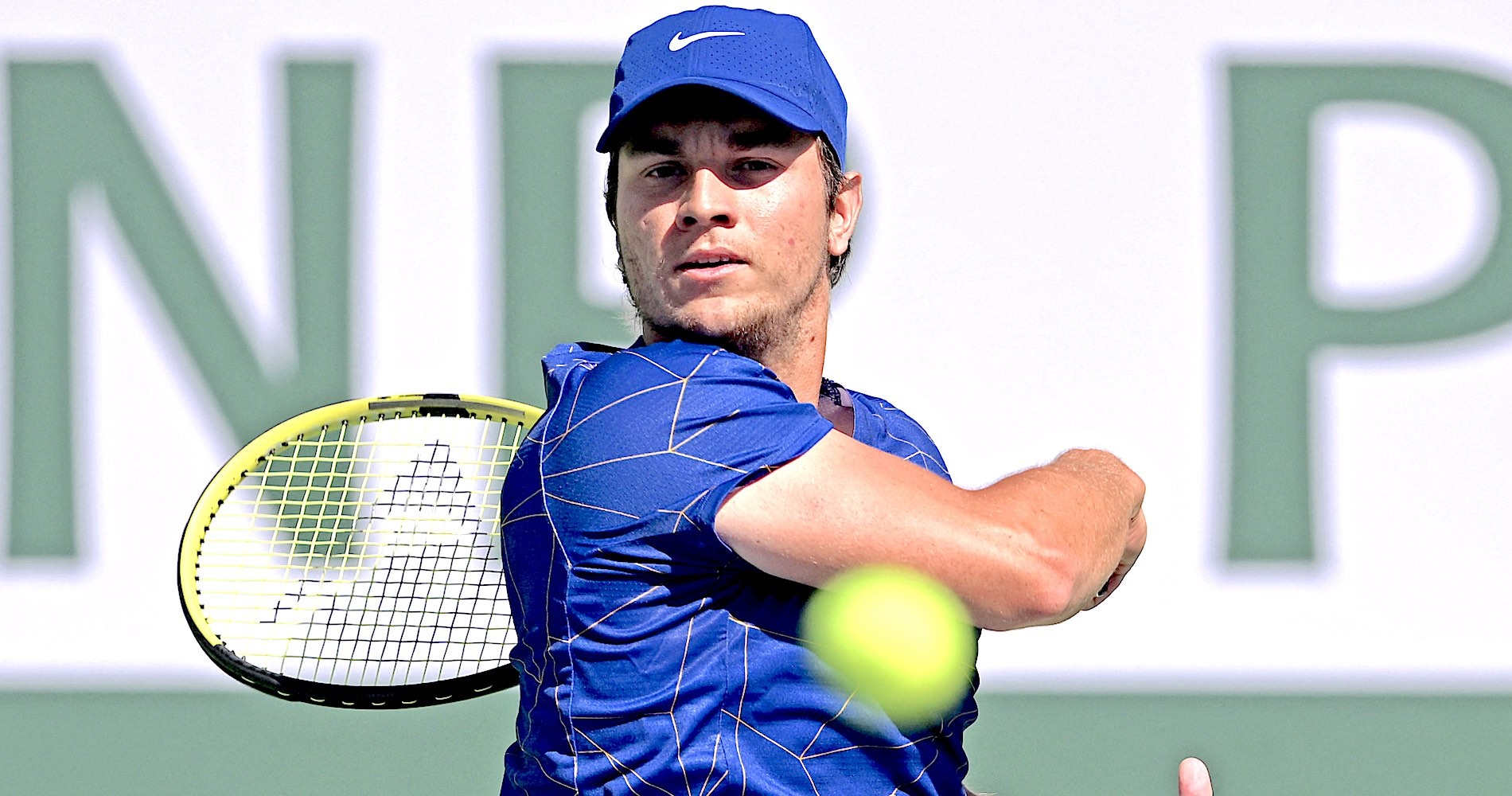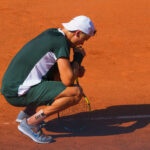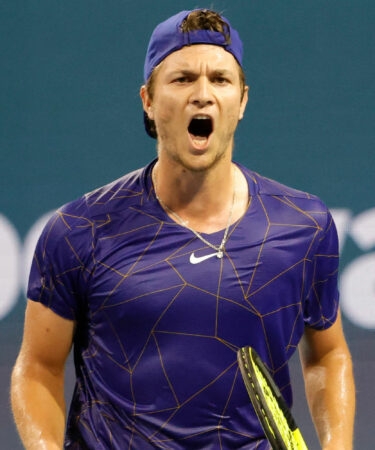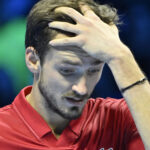Coach Örtegren: “Miomir (Kecmanovic) can be Top 10, of course”
As Miomir Kecmanovic has risen to career-high number 31 in the rankings, his coach Johan Örtegren shared with Tennis Majors some of the secrets to improvements in his game and his way of thinking, and he is certain that Kecmanovic is a future top 10 player
 Johan Örtegren, Paris, 2022 (© Tennis Majors)
Johan Örtegren, Paris, 2022 (© Tennis Majors)
Miomir Kecmanovic has made a big leap in the rankings, as well as in his game, in the first five months of the season. The player himself has handed the credit to David Nalbandian – his coach, former world No. 3 and Wimbledon finalist. Nalbandian deserves plenty of praise, but since September last year there is another coach in the team who does not get talked about enough – perhaps not at all. His name is Johan Örtegren.
The Swedish coach spent six years at Magnus Norman’s Good to Great academy, he worked with Grigor Dimitrov, as well as several other players from his homeland such as Michael Ymer, Rebecca Peterson, Johanna Larsson. He also spent time with recently retired Laura Robson.
Örtegren is no longer part of Norman’s academy, as he wanted to be the master of his own time when he is at home, having been 20-35 weeks on the road. He is on the road now, and his pupil Kecmanovic is due to face the second seed Daniil Medvedev in the third round of the French Open.
In an interview with Tennis Majors, Örtegren discusses Kecmanovic’s progress, his role in the team and his coaching profile, communication with Nalbandian, and long-term goals…
Tennis Majors: What do you feel is the biggest input that you bring to Miomir’s game?
Örtegren: It’s tough to say since I had not seen much of him in the past, so I cannot compare directly, but I think he has improved his shot selection – he doesn’t only rely on power now, he can open up the court with the angles, he can spin high. In one word, much more variety, which gives him more options and room. It is not always about how hard you hit, it is the accuracy, hitting the targets and setting up the point well.
For sure he is moving better now, which makes it easier for him to defend. Even though he is an aggressive player, he cannot be aggressive all the time since the other player is also looking to be aggressive, so he is not only relying on his offensive skills, he can defend well to get back in the rally and then look to go on the offense.
For the majority of matches you’re playing at 70-80% – that is when you are just looking to get the job done, he’s improved this a lot
Johan Örtegren.
When you have that feeling on the court where you are defending better, you do not have to rush, your confidence grows and you make better decisions. It is all connected. I feel he won a lot of matches this year against top opponents without playing his absolute best, but he was competing in every point. For example in Indian Wells, a great result reaching the quarter-finals without playing his best – just by competing and staying in the rally, he was good enough to beat most guys.

It is easy to win when you are playing the best match of the year, but for the majority of matches you’re playing at 70-80% – that is when you are just looking to get the job done. Just look at the best guys, Novak (Djokovic) for example, the same, he always gets the job done, Rafa (Nadal) too, they compete and compete and they are so tough to play against regardless of how well they are playing. This is super important and Misa has improved this a lot.
We have worked on the serve a lot too and I think he has improved there.
TM: What specifically did you work on the serve?
Örtegren: We worked on the turning and on the toss. Now he throws it a bit more left, allowing him to get more grip on the ball. The serve percentage last year was 50-55%, now he is around 65-70%, in Munich the other week he was almost at 80% in a few matches, so of course it makes a big difference when you start more points with the first serve. And since he is so strong from both sides and he returns well, he always has a chance to break, which puts pressure on the opponent.
He is strong on both wings, there is a lot of pressure on the opponent just staying in the rally.
Johan Örtegren
TM: Miomir mentioned that he likes your scouting of opponents, what would you say are your strengths as a coach?
Örtegren: I like the tactical part for sure. It is a thin line, everybody is different – some people want a lot of information, others not so much, you have to adjust accordingly. Misa likes less info in general, but you have to find the right stuff. If you give too much information, then it gets complicated and it is hard to keep track of 10 things. You need to find just a few key things, but ultimately for Misa it is most important to focus on himself first.
I am teaching Misa to set up the points differently, not just pulling the trigger, but creating the point and waiting for the right opportunity. You can also let the other guy miss, the points are worth the same, you don’t get three points for hitting a winner. I think he is beginning to understand this. In the match it is going to be 10-15% winners, the rest are forced and unforced errors. And since he is strong on both wings, there is a lot of pressure on the opponent just staying in the rally.
TM: How does the dynamic work with Nalbandian and you guys?
Örtegren: We communicate for sure. Of course we have a very different background – he is maybe the most gifted player of all time in tennis and he has so much experience from all his big matches, and now he has started coaching. For me, I was only playing Challengers, but I have been coaching for longer, so I think the mix is good, you have a little bit of everything.
The things he started working on in the last year they have already paid off very quickly.
Johan Örtegren
TM: How do you communicate, do you text, speak on the phone…?
Örtegren: Both, it depends on the situation. For example, when I am home and Nalbandian is travelling, I don’t tend to interfere too much. I will congratulate Misa and wish him luck, but if there is something specific, I speak with Nalbandian and he then talks to Misa. The same vice versa.
TM: What would you say at this point is Misa’s ceiling? Where could he be in 2-3 years?
Örtegren: Of course he can be in the top 10. I think he is currently just scratching the surface. The things he started working on in the last year they have already paid off very quickly. It comes down to what you are willing to sacrifice.
TM: What is he like in that regard?
Örtegren: I think the mentality is different, Serbian and Swedish people are very different in general. It takes time to get to know each other and know when to push someone and when maybe to take a step back. Of course it is a process. When you start doing new things like Misa has in the last year and get good results, it is easier to stay on that path. It is easier to trust and thus to guide.












